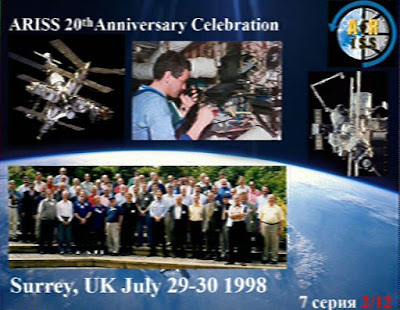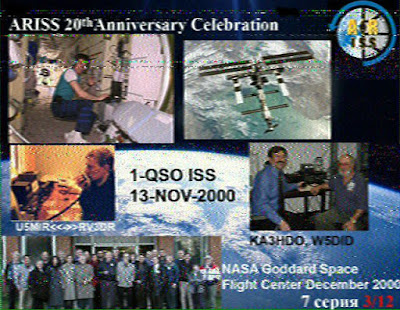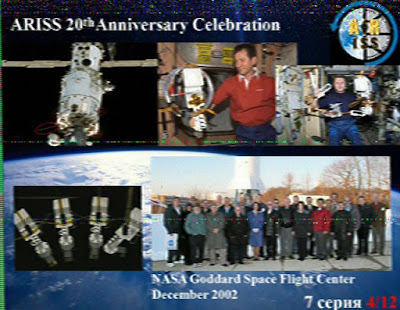Posts Tagged ‘ARISS’
 ARISS 20th Anniversary SSTV
ARISS 20th Anniversary SSTV
The 20 year history of ARISS was displayed through a collection of 12 images highlighting the accomplishments of the project over the last two decades.
As the ISS has orbited the world it has been transmitting the SSTV signals using FM on the usual downlink of 145.800 MHz, here at my QTH in the UK the passes have occurred late at night into the early morning, averaging 3 - 4 reasonable passes each day.
The signal has been very strong and so some excellent low noise images have been received by many people using just modest equipment. While not the greatest technical achievement in the world it nonetheless generates much needed interest in ARISS and amateur space communication.
My own system consisted of the Yaesu FT-857D and MMSSTV running on the shack PC and was left on automatic receive (I was tucked up in bed) and managed to get decent copies of all the images.
Image 8 reminded me of the fun I had back in 2011-2012 of receiving the ARRISAT-1 and was one of the key things that convinced me to finally get off my backside and actually get licensed, even if it took me another 12 months and to this day haven't really cracked satellites myself! My previous blog posts on that can be found at http://nerdsville.blogspot.co.uk/search/label/arissat-1
Here are the best of my images, for a full description of what each one depicts visit http://ariss-sstv.blogspot.co.uk/2017/07/anniversary-image-descriptions.html
 ARISS 20th Anniversary SSTV
ARISS 20th Anniversary SSTV
The 20 year history of ARISS was displayed through a collection of 12 images highlighting the accomplishments of the project over the last two decades.
As the ISS has orbited the world it has been transmitting the SSTV signals using FM on the usual downlink of 145.800 MHz, here at my QTH in the UK the passes have occurred late at night into the early morning, averaging 3 - 4 reasonable passes each day.
The signal has been very strong and so some excellent low noise images have been received by many people using just modest equipment. While not the greatest technical achievement in the world it nonetheless generates much needed interest in ARISS and amateur space communication.
My own system consisted of the Yaesu FT-857D and MMSSTV running on the shack PC and was left on automatic receive (I was tucked up in bed) and managed to get decent copies of all the images.
Image 8 reminded me of the fun I had back in 2011-2012 of receiving the ARRISAT-1 and was one of the key things that convinced me to finally get off my backside and actually get licensed, even if it took me another 12 months and to this day haven't really cracked satellites myself! My previous blog posts on that can be found at http://nerdsville.blogspot.co.uk/search/label/arissat-1
Here are the best of my images, for a full description of what each one depicts visit http://ariss-sstv.blogspot.co.uk/2017/07/anniversary-image-descriptions.html
 LHS Episode #184: Don’t Eat the Baby
LHS Episode #184: Don’t Eat the Baby
 Welcome to the 184th installment of Linux in the Ham Shack. In this episode, your hosts discuss the upward trend in amateur radio licensing, ARES, ARISS, April Fool's Day, R, marketing, Linux distros, bugs in Synergy and TrustedQSL, cw trainers, and much, much more. Thank you for tuning in!. Also, please remember our Hamvention 2017 campaign. We hope to see you all there.
Welcome to the 184th installment of Linux in the Ham Shack. In this episode, your hosts discuss the upward trend in amateur radio licensing, ARES, ARISS, April Fool's Day, R, marketing, Linux distros, bugs in Synergy and TrustedQSL, cw trainers, and much, much more. Thank you for tuning in!. Also, please remember our Hamvention 2017 campaign. We hope to see you all there.
73 de The LHS Crew
 Some Radio Antics
Some Radio Antics
Thankfully things calmed down and was able to put the antenna back up but I seemed a little deaf on VHF/UHF dropping several S-points on local repeaters and then started to see high VSWR readings. The incessant rain had somehow got into the connector under the collinear despite being generously wrapped in self amalgamating tape. I replaced the connector and removed a couple of feet of coax in case any had seeped into the cable.
Like much of the UK amateur community I have been trying to listen in to British Astronaut Major Tim Peake during a number of ARISS UK school contacts during the Principia mission on the International Space Station. It is pleasing to see the enthusiasm, interest and publicity it has generated for the hobby.
There is another contact tomorrow (Friday 26th February 2016 at 1440UTC) with the City of Norwich School. While reception of the first two contacts proved a little disappointing for me, the one last week was much better and I made a video during the pass.
The Astronauts are certainly busy on the space station and there was an ARISS contact this morning with an Italian school. It was a low pass here only reaching 7 degrees above the horizon but was pleased to capture Tim Kopra conversing. I was using just the X-50 collinear on the FT857-D
The repaired ATU and a new balun on the OCFD has made a big difference to HF. It is much less noisy and I am now able to match the antenna to 80m something I could never do before. While it will be very inefficient on such a short antenna I did run a little over 2W last night on WSPR as a test, and was pleasantly surprised.
I have also been doing some JT65 and for the first time some JT9 inspired by a demonstration at SKARS and I was pleased to make a JT9 QSO with JA5BDZ on 15m using 10W.
A big help to HF has been tracking down the source of my recent QRM, which wasn't as many suggested my evil PLT devices but in fact the now redundant wireless router. While the WiFi was switched off it was still being used as a network switch and for some reason had suddenly become RF noisy, it wasn't the switching PSU but the actual unit and would happen a few hours after being switched on. Funny thing it is not the first time I've had an access point suddenly emit QRM.
A couple of weeks ago I went out with Stewart (M0SDM) to assist him flying his kite antenna and we operated under the club callsign MX0SKR, for a couple of hours, it was great fun.
Last weekend I also helped my brother David (M6GTD) install a couple of antennas at the family home. He can finally use the radio he brought at the Hamfest back in September, a Diamond X-50 dual band collinear and a home brewed 33ft long OCFD should get him on the air!
David helped me at the Hamfest with the balloon launch
My apologies if this blog post sounds like a bit like an excited child recanting his holiday "I did this, and then I did this and I also did that" I hope to post something a little more coherent and structured soon!
 Some Radio Antics
Some Radio Antics
Thankfully things calmed down and was able to put the antenna back up but I seemed a little deaf on VHF/UHF dropping several S-points on local repeaters and then started to see high VSWR readings. The incessant rain had somehow got into the connector under the collinear despite being generously wrapped in self amalgamating tape. I replaced the connector and removed a couple of feet of coax in case any had seeped into the cable.
Like much of the UK amateur community I have been trying to listen in to British Astronaut Major Tim Peake during a number of ARISS UK school contacts during the Principia mission on the International Space Station. It is pleasing to see the enthusiasm, interest and publicity it has generated for the hobby.
There is another contact tomorrow (Friday 26th February 2016 at 1440UTC) with the City of Norwich School. While reception of the first two contacts proved a little disappointing for me, the one last week was much better and I made a video during the pass.
The Astronauts are certainly busy on the space station and there was an ARISS contact this morning with an Italian school. It was a low pass here only reaching 7 degrees above the horizon but was pleased to capture Tim Kopra conversing. I was using just the X-50 collinear on the FT857-D
The repaired ATU and a new balun on the OCFD has made a big difference to HF. It is much less noisy and I am now able to match the antenna to 80m something I could never do before. While it will be very inefficient on such a short antenna I did run a little over 2W last night on WSPR as a test, and was pleasantly surprised.
I have also been doing some JT65 and for the first time some JT9 inspired by a demonstration at SKARS and I was pleased to make a JT9 QSO with JA5BDZ on 15m using 10W.
A big help to HF has been tracking down the source of my recent QRM, which wasn't as many suggested my evil PLT devices but in fact the now redundant wireless router. While the WiFi was switched off it was still being used as a network switch and for some reason had suddenly become RF noisy, it wasn't the switching PSU but the actual unit and would happen a few hours after being switched on. Funny thing it is not the first time I've had an access point suddenly emit QRM.
A couple of weeks ago I went out with Stewart (M0SDM) to assist him flying his kite antenna and we operated under the club callsign MX0SKR, for a couple of hours, it was great fun.
Last weekend I also helped my brother David (M6GTD) install a couple of antennas at the family home. He can finally use the radio he brought at the Hamfest back in September, a Diamond X-50 dual band collinear and a home brewed 33ft long OCFD should get him on the air!
David helped me at the Hamfest with the balloon launch
My apologies if this blog post sounds like a bit like an excited child recanting his holiday "I did this, and then I did this and I also did that" I hope to post something a little more coherent and structured soon!
 My APRS broadcasts received by the ISS
My APRS broadcasts received by the ISS
I screen capped the evidence from the website http://ariss.net which documents Amateur Radio data digipeated by the ISS. In order to appear on the page, a position report in a valid APRS format must be received and then digipeated through the ISS system, then be heard by an internet gateway station, which then forwards it on to the APRS Internet System.
Okay it sounds a bit more impressive when put like that ;-)
 |
| The map showing received stations, M6GTG is me! |
 |
| The detail of my report |
 |
| List of stations with time stamps, showing me! |
 |
| List of digirepeated messages |
It consists of a small embedded PC running embedded XP, the sound card output was connected to the microphone input of my Baofeng UV-5R+ operating in VOX mode set to 145.825MHz. The radio was connected through my power/SWR meter in to the X-50 antenna. I used the UV-5R+ instead of the UV-3R since it has a little more power and better audio. I had a SWR of around 1:1.2 and outputting 4W.
The software I used was UISS from ON6MNU and the AGWPE packet engine. It has taken a little time to work out how to setup UISS into auto-beacon mode and putting in the time of the next decent pass (approx 45 degrees elevation) I set it to broadcast position and text data messages every 30 seconds.
| The embedded PC running UISS |
| UV5R+ in VOX mode on 145.825MHz |
| The power meter showed 4W output, SWR about 1:1.2 |
I stood out in the dark, hoping to see the ISS pass over but the cloud cover was too thick and monitored using a handheld scanner. I heard my transmissions obviously and the ISS broadcasts as it repeated received messages, but I didn't know if any were mine till I got back to the PC.
 Free (As In Beer) Satellite Track Software – GPredict
Free (As In Beer) Satellite Track Software – GPredict
So after ARISSat-1 was deployed, I have been trying to receive a signal from it. Specifically SSTV signals. I haven’t been very sucsessful. For one, I haven’t been able to be at the radio when it makes a pass because of work and family commitments. I’m hoping this week, I’ll have more time to sit down and be there to listen for. But the first thing is, I need to know where it is.
I took a look at some of the tracking software out there for my Mac and found that there is only really one program that I could find for the Mac natively, that was “fully” featured with all the bells and whistles. But it was pretty steeply priced for me at $98. I decided t see what else was out there for free. The only one I found that I liked, was Gpredict. It’s written for Linux, but there are ports for it for Windows and Mac, and it’s open source, so it’s free.
The only draw back was, it wasn’t native, so I had to install from source or use MacPorts, a project that ports open source Linux software to the Mac platform, since Mac OS X is based on FreeBSD. The install took me about an hour because of all the dependencies needed for GPredict. MacPort installed them all with no problem.
So after some false starts and finally reading some more info on it, I managed to get it running on my Macbook Pro. After I ran it for the first time, it saw that the info for the satellites was out of date and asked to do an update, giving me the option to do it online or through a file I downloaded.
Gpredict supports fast and accurate real-time satellite tracking using the NORAD SGP4/SDP4 algorithms, No software limit on the number of satellites or ground stations and Radio and antenna rotator control for autonomous tracking.
After uploading and doing a little more research, I was able to find ARISSat-1 on the list, under RadioSkaf-V. Once I found it, I was able to track it no problem. Now, it’s just a matter of having the time to do it. In the meantime, I encourage you to check out GPredict, and try it out. Since it’s free you’ve got nothing to lose.
But if you also have a suggestion for Mac satellite tracking software, please, share it in the comments, and share any experience you have with GPredict.
73.
Rich also writes a Tech blog and posts stories every Tuesday and Thursday on Q103, The Rock of Albany’s website, as well as Amateur Radio stories every Monday thru Friday here on AmiZed Studios.




























